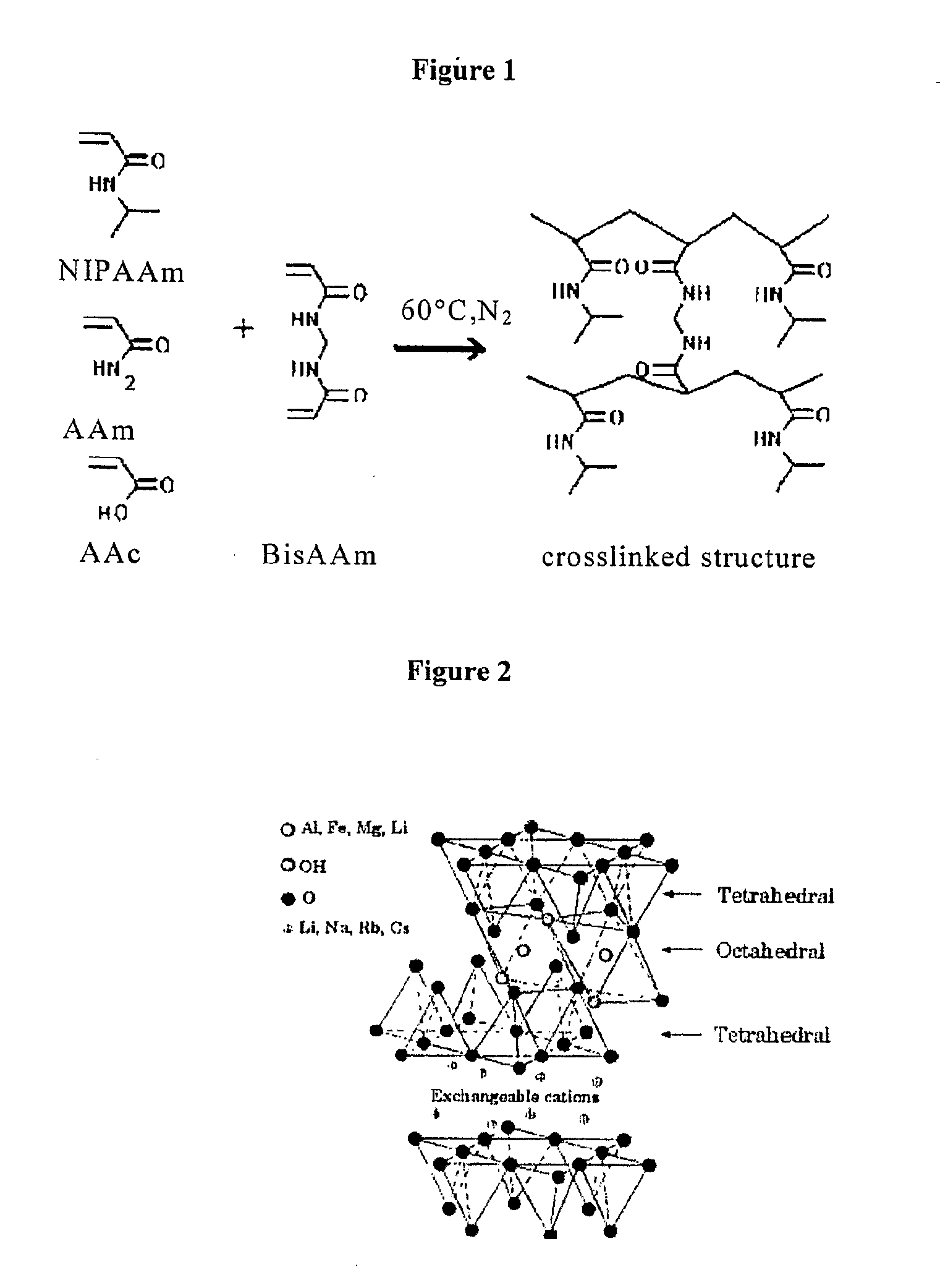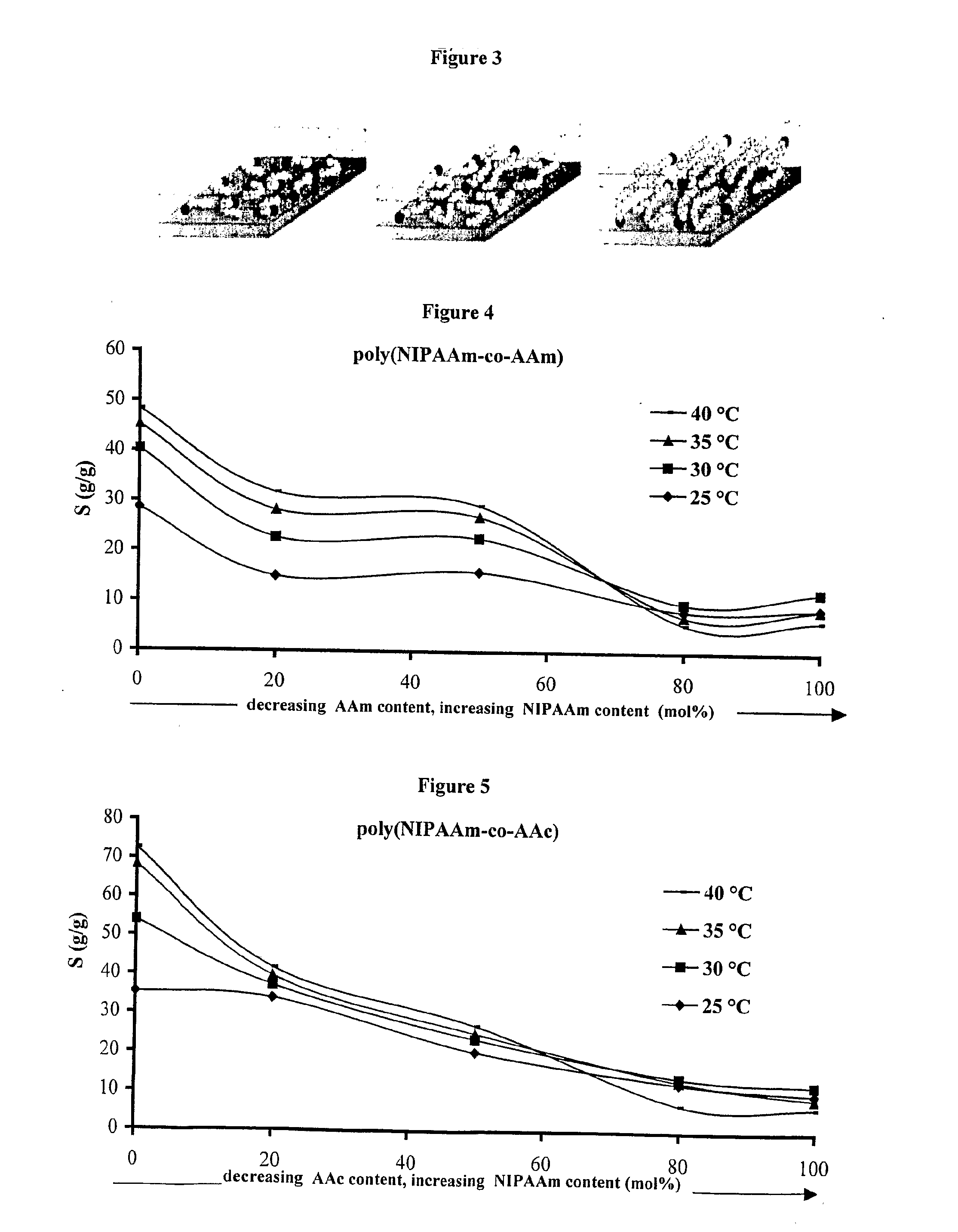Layer silicate nanocomposites of polymer hydrogels and their use in tissue expanders
a technology of polymer hydrogels and nanocomposites, which is applied in the direction of synthetic polymeric active ingredients, surgery, diagnostics, etc., can solve the problems of increasing the risk of filling, and increasing and achieving the effect of reducing the risk of filling
- Summary
- Abstract
- Description
- Claims
- Application Information
AI Technical Summary
Problems solved by technology
Method used
Image
Examples
example 4
Synthesis of Organophilized Montmorillonite
[0076]The amine is dissolved in acidified ethanol-water mixture and added to Na-montmorillonite pre-swollen in distilled water at a ratio of 100 meq / g; the system is next stirred for 24 hours. After the completion of the ion exchange the suspensions are centrifuged and filtered. The hydrophobized filler obtained in this way is dried and ground to a particle size of 200 μm.
example 5
Synthesis of 100% AAm-Based Hydrogel Nanocomposite Containing 5 wt % C4-Montmorillonite
[0077]2.5 mol / l AAm monomer stock solution and 0.1 mol / l BisAAm crosslinker stock solution are prepared in distilled water. 4 ml of monomer stock solution (0.7108 g) and 0.5 ml of crosslinker stock solution (7.7085*10−3 g) are added to a test tube, thereby setting the monomer / crosslinker ratio to 200. 0.03823 g of C4-montmorillonite is dispersed in 5 ml distilled water and the dispersion obtained is added to the previously prepared monomer / crosslinker solution. Finally, 1.25*10−4 g of KPS (initiator) and 7.75*10−3 g of TEMED (accelerator) are added to this solution and the solution obtained is filled up to 10 ml with distilled water. The test tube is flushed with N2 for 3 to 5 min, closed air-tight and placed in a 50-60° C. water bath for half an hour. After the completion of the polymerization the composite obtained is removed from the test tube, cut into pieces with a scalpel and dried to consta...
example 6
Synthesis of 100% AAc-Based Hydrogel Nanocomposite Containing 5 wt % C12-Montmorillonite
[0080]2.5 mol / 1 monomer stock solution (AAc) and 0.1 mol / l crosslinker stock solution (BisAAm) are prepared in distilled water. 4 ml of monomer stock solution (0.7206 g) and 0.5 ml of crosslinker stock solution (7.7085*10−3 g) are added to a test tube, thereby setting the monomer / crosslinker ratio to 200. 0.03875 g of C12-montmorillonite is dispersed in 5 ml of distilled water and the dispersion obtained is added to the previously prepared monomer / crosslinker solution. Finally, 1.25*10−4 g of KPS (initiator) and 7.75*10−3 g of TEMED (accelerator) are added to this solution and the solution obtained is filled up to 10 ml with distilled water. The test tube is flushed with N2 for 3 to 5 min, closed air-tight and placed in a 50-60° C. water bath for half an hour. After the completion of the polymerization the composite obtained is removed from the test tube, cut into pieces with a scalpel and dried ...
PUM
| Property | Measurement | Unit |
|---|---|---|
| mol % | aaaaa | aaaaa |
| mol % | aaaaa | aaaaa |
| mol % | aaaaa | aaaaa |
Abstract
Description
Claims
Application Information
 Login to View More
Login to View More - R&D
- Intellectual Property
- Life Sciences
- Materials
- Tech Scout
- Unparalleled Data Quality
- Higher Quality Content
- 60% Fewer Hallucinations
Browse by: Latest US Patents, China's latest patents, Technical Efficacy Thesaurus, Application Domain, Technology Topic, Popular Technical Reports.
© 2025 PatSnap. All rights reserved.Legal|Privacy policy|Modern Slavery Act Transparency Statement|Sitemap|About US| Contact US: help@patsnap.com



